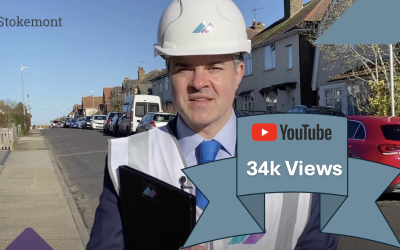Boundary reports are generally required when there is a boundary dispute. This may take place when two different parties, usually property owners, disagree the location, width, ownership or maintenance liabilities of the boundary line.
Boundaries are generally set by determining features such as a fence, wall, hedge, driveway, tree, post or even a stone marker.
Over the years of the property owners and various occupants, the boundaries can often be moved, diverted, adjusted and even overgrown.
While the legal boundary line will always be indicated on the Land Registry Title Plan, often there will be to a very high scale, usually 1 to 1,250.
In practice, this means that when a Surveyor attempts to determine the boundary line using Land Registry Title Plan scale, there can be as much as a one metre wider uncertainty as to where the true boundary line lies. Because of this, the Surveyor will conduct a variety of different tests on site and undertake desktop research in order to write up an adequate report. They will gather these facts and their experience and knowledge and express their professional opinion on where the boundary line lies and detail how they came up with that opinion.
The Boundary Surveyor when on site usually takes a series of measurements (where safe to do so) and take photographs in order to gather an accurate assessment of what the current projection of the boundary line is.
After the site inspection, the Boundary Surveyor will undertake desktop research, which includes looking at the Land Registry details, the Land Registry Map Search, previous Planning Applications, Ordnance Survey Maps, Historical and Present Maps and even Google Earth, Google Street View and Bing Maps in order to gain evidence to where the Boundary Line may lie.
This report can be prepared on behalf of one of the parties, or behalf of both parties to the boundary dispute.
If the parties are in agreement with the report’s findings, a Boundary Agreement can be prepared, which will be signed by both respective parties to the dispute. It can then be registered with the Land Registry to ensure there is never any future dispute for the current or future owners.
In the event that the parties to the dispute are unable to resolve matters and the boundary dispute remains outstanding, the parties can proceed to court to have the matter heard in front of a judge. This can be costly and cost in the region of £15,000 to £100,000 and take 3 to 18 months to resolve possibly longer depending on the complexity of the case.
The outcome of the court procedures will be a court order which determinate the location, ownership and maintenance liabilities of the boundary.
We hope this blog post was informative and happy to help in any way on this regard. If you have a Boundary dispute or have a question, why not give us a call and take advantage of the 60 minutes free consultation with one of our Surveyors? We are happy to assist where we can.




